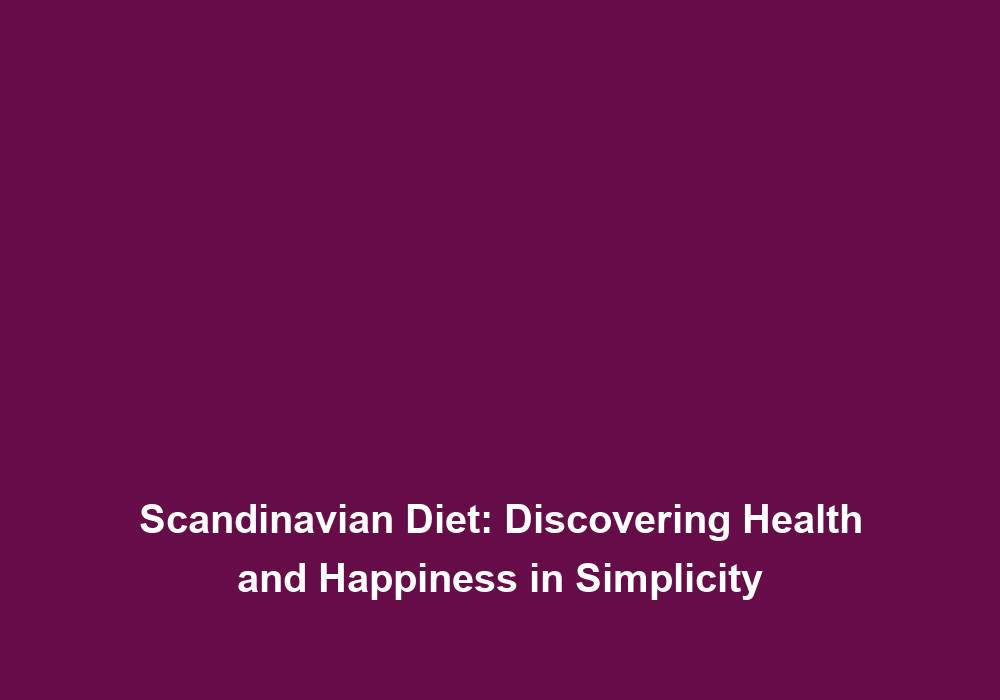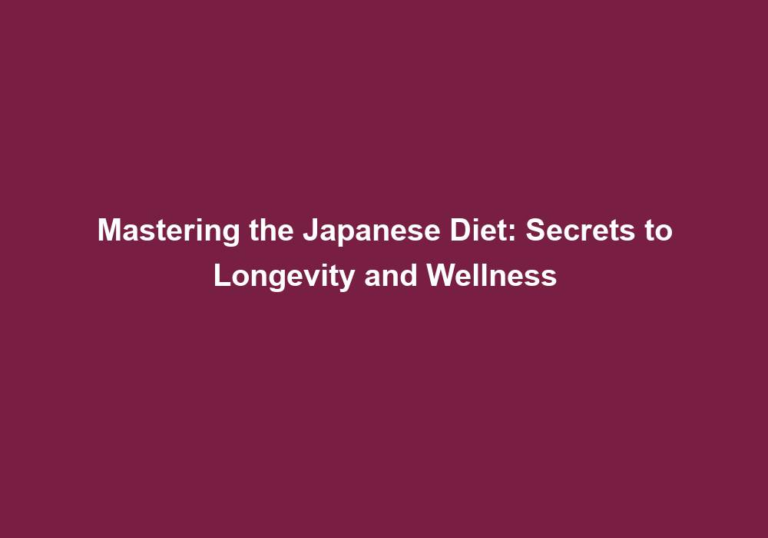Scandinavian Diet: Discovering Health and Happiness in Simplicity
The Scandinavian diet, also known as the Nordic diet, is gaining popularity worldwide for its numerous health benefits and emphasis on simple, natural ingredients. This dietary pattern is inspired by the traditional eating habits of Nordic countries like Sweden, Norway, Denmark, Finland, and Iceland. The Scandinavian diet promotes overall well-being by focusing on fresh, locally sourced foods, seasonal produce, and sustainable eating practices. In this article, we will delve into the key principles and benefits of the Scandinavian diet, helping you understand how it can transform your health and bring happiness to your life.
Key Principles of the Scandinavian Diet
-
Simplicity and Minimalism: The Scandinavian diet revolves around keeping things simple and minimalistic. It promotes the consumption of whole, unprocessed foods over highly refined and artificial products. By focusing on natural, wholesome ingredients, this approach encourages a more holistic and sustainable lifestyle. By simplifying our diet, we can reduce the intake of additives, preservatives, and artificial ingredients that may have negative effects on our health.
-
Sustainability and Locally Sourced Foods: The Nordic countries are known for their commitment to sustainable practices. The Scandinavian diet emphasizes the consumption of locally sourced, seasonal foods, reducing the carbon footprint associated with long-distance transportation. Choosing local and organic produce not only benefits the environment but also ensures fresher and more nutritious meals. By supporting local farmers and producers, we contribute to the preservation of traditional farming methods and help maintain biodiversity.
-
High-Quality Protein: The Scandinavian diet incorporates a moderate amount of high-quality protein sources such as fish, lean meats, legumes, and dairy products. These protein sources provide essential nutrients and amino acids necessary for maintaining muscle mass, promoting satiety, and supporting overall health. Including a variety of protein sources in our diet ensures that we obtain all the essential amino acids needed for optimal bodily functions.
-
Abundance of Fresh Fruits and Vegetables: Fruits and vegetables form a significant part of the Scandinavian diet. These nutrient-dense foods are packed with vitamins, minerals, and antioxidants that boost immunity and protect against chronic diseases. The diet emphasizes the consumption of a wide variety of colorful fruits and vegetables, providing a range of essential nutrients. By incorporating a rainbow of fruits and vegetables into our meals, we can ensure a diverse and balanced nutrient intake.
-
Healthy Fats: Unlike traditional low-fat diets, the Scandinavian diet embraces healthy fats, particularly those found in fatty fish, nuts, seeds, and plant oils. These fats, including omega-3 fatty acids, are essential for brain health, reducing inflammation, and supporting cardiovascular well-being. Including sources of healthy fats in our diet can also enhance the absorption of fat-soluble vitamins and provide satiety, helping us feel satisfied and reducing the risk of overeating.
-
Whole Grains: Whole grains, such as oats, rye, barley, and whole wheat, are staples in the Scandinavian diet. They are rich in fiber, vitamins, and minerals, providing sustained energy and promoting digestive health. Whole grains also play a role in reducing the risk of chronic diseases, including heart disease and type 2 diabetes. By choosing whole grains over refined grains, we can benefit from their higher nutrient content and fiber, which aids in digestion and helps regulate blood sugar levels.
-
Moderate Consumption of Sugar and Processed Foods: The Scandinavian diet discourages excessive consumption of sugary treats and processed foods. Instead, it encourages individuals to satisfy their sweet tooth with natural alternatives like berries and other fruits. By minimizing the intake of added sugars and processed foods, this diet aims to reduce the risk of obesity, diabetes, and other lifestyle-related conditions. By reducing our reliance on processed foods, we can avoid hidden sugars, unhealthy fats, and artificial additives that can negatively impact our health.
Health Benefits of the Scandinavian Diet
By adopting the Scandinavian diet, individuals may experience a wide range of health benefits:
-
Heart Health: The emphasis on whole grains, lean proteins, fatty fish, and healthy fats in the Scandinavian diet contributes to a heart-healthy eating pattern. These foods help lower LDL (bad) cholesterol levels, reduce blood pressure, and decrease the risk of cardiovascular diseases. By incorporating these heart-healthy foods into our diet, we can support the health and function of our cardiovascular system.
-
Weight Management: The Scandinavian diet promotes weight management by focusing on wholesome, nutrient-rich foods and discouraging excessive intake of sugary and processed foods. The high fiber content of fruits, vegetables, and whole grains aids in digestion, enhances satiety, and supports healthy weight loss or maintenance. Additionally, the emphasis on lean proteins helps build and maintain muscle mass, which can further contribute to a healthy body composition.
-
Diabetes Prevention and Management: The Scandinavian diet’s low glycemic load, thanks to its emphasis on whole grains and minimally processed foods, can help regulate blood sugar levels and reduce the risk of developing type 2 diabetes. Additionally, the diet’s balanced macronutrient composition aids in glycemic control for individuals with diabetes. By choosing low-glycemic foods and balancing our carbohydrate intake with protein and healthy fats, we can better manage blood sugar levels and reduce the risk of diabetes-related complications.
-
Nutritional Adequacy: The Scandinavian diet emphasizes the consumption of nutrient-dense foods, ensuring that individuals meet their daily nutritional requirements. The abundance of fruits, vegetables, whole grains, and lean proteins provides essential vitamins, minerals, fiber, and antioxidants necessary for optimal health. By focusing on nutrient-dense foods, we can ensure we are nourishing our bodies with all the essential nutrients needed for overall well-being.
-
Anti-Inflammatory Properties: The inclusion of fatty fish, rich in omega-3 fatty acids, and other anti-inflammatory foods in the Scandinavian diet helps reduce inflammation within the body. This can alleviate symptoms of chronic conditions like arthritis and promote overall well-being. Omega-3 fatty acids have been shown to have anti-inflammatory effects, which can help reduce the risk of chronic inflammatory diseases and improve joint health.
-
Improved Digestive Health: The high fiber content of the Scandinavian diet aids in maintaining a healthy digestive system. Whole grains, fruits, and vegetables promote regular bowel movements and prevent constipation. Additionally, the diet’s emphasis on fermented foods, such as yogurt and sauerkraut, supports gut health by providing beneficial probiotics. Probiotics help maintain a healthy balance of gut bacteria, which is essential for optimal digestion and absorption of nutrients.
In conclusion, the Scandinavian diet offers a simple and sustainable approach to healthy eating. By prioritizing fresh, locally sourced foods, whole grains, lean proteins, and healthy fats, individuals can reap numerous health benefits, including improved heart health, weight management, diabetes prevention, and enhanced overall well-being. Embrace the simplicity and nourishment of the Scandinavian diet, and take the first step towards a healthier, happier life.







